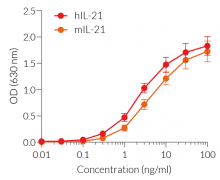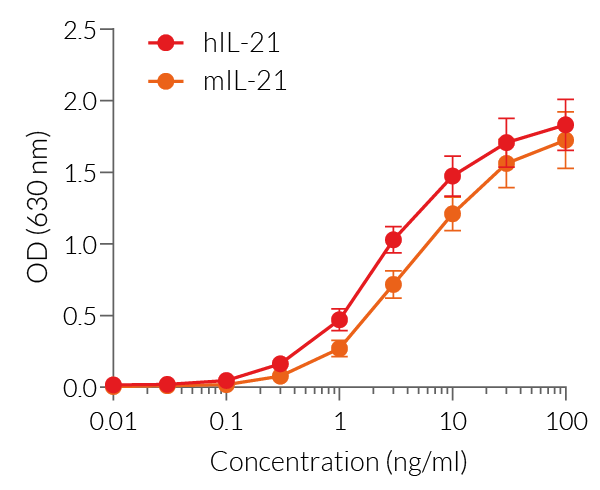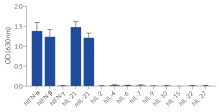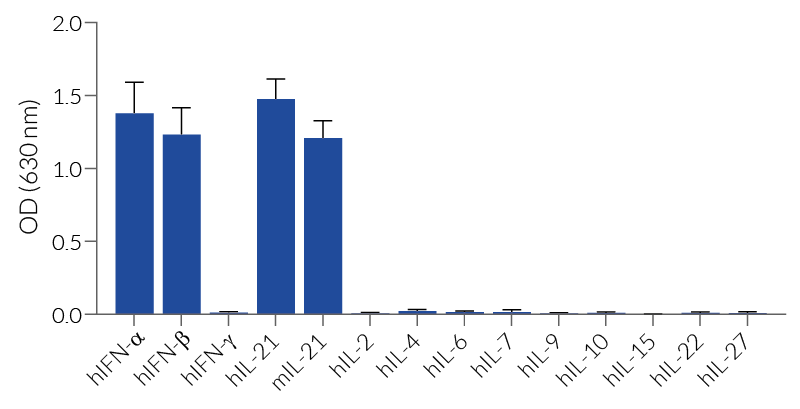IL-21 Reporter HEK 293 Cells
| Product | Unit size | Cat. code | Docs. | Qty. | Price | |
|---|---|---|---|---|---|---|
|
HEK-Blue™ IL-21 Cells Human & murine IL-21 cytokine HEK293 reporter cells |
Show product |
3-7 x 10e6 cells |
hkb-il21
|
|

HEK-Blue™ IL-21 Cells signaling pathway
Interleukin-21 Reporter Cells
HEK-Blue™ IL-21 cells were engineered from the human embryonic kidney HEK 293 cell line to detect bioactive interleukin 21 (IL-21) by monitoring the activation of the JAK/STAT3 pathway. IL-21 is a secreted cytokine that plays an essential role in promoting the proliferation and development of T cell subsets and inducing B cell generation and differentiation into plasma cells [1].
Description:
HEK-Blue™ IL-21 cells were generated by stable overexpression of the genes encoding the alpha chain of human IL-21 receptor (IL-21Rα), IL-2Rγ, JAK3, STAT3, and a STAT3-inducible secreted embryonic alkaline phosphatase (SEAP) reporter. STAT3-dependent SEAP activity is readily assessable in the supernatant using QUANTI-Blue™ Solution, a detection reagent. Of note, HEK-Blue™ IL-21 cells also respond to human type I IFNs (IFN-α/IFN-β), but not human type II interferons (IFN-γ; see figures).
Key Features:
- Fully functional IL-21 signaling pathway
- Readily assessable STAT3-inducible SEAP reporter activity
Applications:
- Detection of human and murine IL-21
- Screening of anti-IL-21 and anti-IL-21R antibodies
References:
1. Spolski R. et al., 2014. Interleukin-21: a double-edged sword with therapeutic potential. Nat Rev Drug Discov. 13(5):379-95.
Back to the topSpecifications
Antibiotic resistance: Blasticidin, Hygromycin, Puromycin, Zeocin®
Growth medium: DMEM, 4.5 g/l glucose, 2 mM L-glutamine, 10% (v/v) heat-inactivated fetal bovine serum, 100 U/ml penicillin, 100 μg/ml streptomycin, 100 μg/ml Normocin™
Guaranteed mycoplasma-free
Specificity: human and murine IL-21
Detection ranges:
- 0.1 - 100 ng/ml for human IL-21
-
1 - 100 ng/ml for murine IL-21
This product is covered by a Limited Use License (See Terms and Conditions).
Back to the topContents
- 1 vial containing 3-7 x 106 cells
- 2 x 1 ml HEK-Blue™ Selection (250X concentrate)
- 1 ml of Puromycin (10 mg/ml)
- 1 ml Normocin™ (50 mg/ml)
- 1 ml of QB reagent and 1 ml of QB buffer (sufficient to prepare 100 ml of QUANTI-Blue™ Solution, a SEAP detection reagent)
![]() Shipped on dry ice (Europe, USA, Canada, and some areas in Asia)
Shipped on dry ice (Europe, USA, Canada, and some areas in Asia)
Details
Interleukin 21 (IL-21) is a cytokine mainly produced by CD4+ T cells and natural killer T (NKT) cells. It has pleiotropic actions on a wide range of immune (i.e. lymphoid and myeloid populations) and non-immune cell types (i.e. epithelial cells) [1,2]. IL-21 belongs to the common γ chain cytokine family. Its receptor comprises the IL-21Rα (CD360) and IL-2Rγ (CD132) chains and it signals through tyrosine kinases of the Janus family (JAK1 and JAK3) and signal transducer and transcription activators (STAT). STAT3 plays a major role in the biological actions of IL-21, and some functions have been also attributed and suggested for STAT1 and STAT5, respectively [1-3]. Furthermore, IL-21 facilitates the PI3K/AKT and MAPK pathways, which both contribute to IL-21 signal transmission [1-3]. IL-21 is referred to as a double-edged sword cytokine, with key roles in anti-tumor and anti-viral responses, but also in promoting the development of autoimmune diseases (e.g. systemic lupus erythematosus and rheumatoid arthritis) [1-3]. Recombinant IL-21 as well as anti-IL-21 monoclonal antibodies are being investigated for therapeutic use in cancer and autoimmune diseases [1-3].
1. Spolski R. et al., 2014. Interleukin-21: a double-edged sword with therapeutic potential. Nat Rev Drug Discov. 13(5):379-95.
2. Leonard WJ. et al., 2016. IL-21 signaling in immunity. F1000Res. doi: 10.12688/f1000research.7634.1.
3. Long D. et al., 2019. Clinical significance and immunobiology of IL-21 in autoimmunity. J Autoimmunity. 99:1-14.








